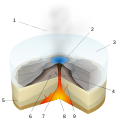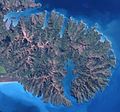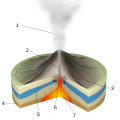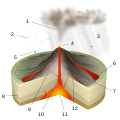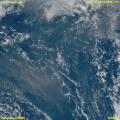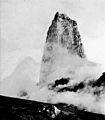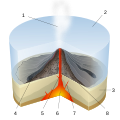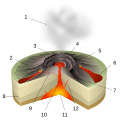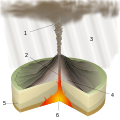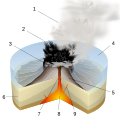Portal:Volcanoes
The Volcanoes portal

A volcano is commonly defined as a vent or fissure in the crust of a planetary-mass object, such as Earth, that allows hot lava, volcanic ash, and gases to escape from a magma chamber below the surface.
On Earth, volcanoes are most often found where tectonic plates are diverging or converging, and because most of Earth's plate boundaries are underwater, most volcanoes are found underwater. For example, a mid-ocean ridge, such as the Mid-Atlantic Ridge, has volcanoes caused by divergent tectonic plates whereas the Pacific Ring of Fire has volcanoes caused by convergent tectonic plates. Volcanoes resulting from divergent tectonic activity are usually non-explosive whereas those resulting from convergent tectonic activity cause violent eruptions. Volcanoes can also form where there is stretching and thinning of the crust's plates, such as in the East African Rift, the Wells Gray-Clearwater volcanic field, and the Rio Grande rift in North America. Volcanism away from plate boundaries most likely arises from upwelling diapirs from the core–mantle boundary called mantle plumes, 3,000 kilometres (1,900 mi) deep within Earth. This results in hotspot volcanism or intraplate volcanism, in which the plume may cause thinning of the crust and result in a volcanic island chain due to the continuous movement of the tectonic plate, of which the Hawaiian hotspot is an example. Volcanoes are usually not created at transform tectonic boundaries where two tectonic plates slide past one another.
Volcanoes, based on their frequency of eruption or volcanism, can be defined as either active, dormant or extinct. Active volcanoes have a recent history of volcanism and are likely to erupt again, dormant ones have not erupted in a long time but may erupt later, while extinct ones are not capable of eruption at all. These categories aren't entirely uniform; they may overlap for certain examples.
Large eruptions can affect atmospheric temperature as ash and droplets of sulfuric acid obscure the Sun and cool Earth's troposphere. Historically, large volcanic eruptions have been followed by volcanic winters which have caused catastrophic famines.
Other planets besides Earth have volcanoes. For example, volcanoes are very numerous on Venus. Mars has significant volcanoes. In 2009, a paper was published suggesting a new definition for the word 'volcano' that includes processes such as cryovolcanism. It suggested that a volcano be defined as 'an opening on a planet or moon's surface from which magma, as defined for that body, and/or magmatic gas is erupted.'
This article mainly covers volcanoes on Earth. See § Volcanoes on other celestial bodies and cryovolcano for more information. (Full article...)
Selected article -

A series of small volcanic earthquakes measuring less than 4.0 on the Richter magnitude scale took place in the sparsely populated Nazko area of the Central Interior of British Columbia, Canada, from October 9, 2007, to June 12, 2008. They occurred just west of Nazko Cone, a small tree-covered cinder cone that last erupted about 7,200 years ago.
No damage or casualties resulted from the Nazko earthquakes, which were too small to be felt by people, but local seismographs recorded them. The earthquake swarm occurred at the eastern end of a known volcanic zone called the Anahim Volcanic Belt. This is an east–west trending line of volcanic formations extending from the Central Coast to the Central Interior of British Columbia. (Full article...)
Did you know
- ... that The Volcano (pictured) in northwestern British Columbia is the youngest known volcano in Canada, and its last eruption likely took place only 150 years ago?
- ... that the Geology of the Northland Region, New Zealand, includes exotic seafloor rocks, an extinct volcanic arc, and a massive tombolo?
- ... that volcanic eruptions may have contributed to the population decline of the Pink-headed warbler?
- ... that CenSeam is an initiative to biologically sample seamounts (submarine volcanoes), of which about 100,000 exist and only 350 have received attention?
- ... that the Graveyard Seamounts are all named morbidly, with names such as Pyre Seamount, Morgue Seamount, and Zombie Seamount?
- ... that the tablemount structure of Sedlo Seamount, a seamount (submarine volcano), indicates that it used to be above the water?
- ... that observations and samplings from Jasper Seamount show that it is very similar to Hawaiian volcanoes?
- ... that South Chamorro Seamount, a submarine mud volcano near the Mariana Trench, is only the second such structure in the world to be sampled?
General images
Selected biography -
George Julius Poulett Scrope FRS (10 March 1797 – 19 January 1876) was an English geologist and political economist as well as a Member of Parliament and magistrate for Stroud in Gloucestershire.
While an undergraduate at Cambridge, through the influence of Edward Clarke and Adam Sedgwick he became interested in mineralogy and geology. During the winter of 1816–1817 he was at Naples, and was so keenly interested in Vesuvius that he renewed his studies of the volcano in 1818; and in the following year visited Etna and the Lipari Islands. In 1821 he married the daughter and heiress of William Scrope of Castle Combe, Wiltshire, and assumed her name; and he entered the House of Commons of the United Kingdom in 1833 as MP for Stroud, retaining his seat until 1868.
Meanwhile he began to study the volcanic regions of central France in 1821, and visited the Eifel district in 1823. In 1825 he published Considerations on Volcanos, leading to the establishment of a new theory of the Earth, and in the following year was elected FRS. This earlier work was subsequently amplified and issued under the title of Volcanos (1862); an authoritative text-book of which a second edition was published ten years later. In 1827 he issued his classic Memoir on the Geology of Central France, including the Volcanic formations of Auvergne, the Velay and the Vivarais, a quarto volume illustrated by maps and plates. The substance of this was reproduced in a revised and somewhat more popular form in The Geology and Extinct Volcanos of Central France (1858). These books were the first widely published descriptions of the Chaîne des Puys, a chain of over 70 small volcanoes in the Massif Central. (Full article...)
Selected picture
 |
Io moon taken by NASA's Galileo probe. This image shows two volcanic eruptions. The one on the horizon is 140 km (87 mi) high, the other is 75 km (47 mi) high. Io is the innermost of the four Galilean moons of Jupiter. It is named after Io, one of Zeus's many love interests in Greek mythology.
Selected quote
"This ground is hot enough to cook the Sunday roast!"
— John Seach, remarking on his boots melting whilst on the slope of Lopevi Volcano, 2000
Related portals
WikiProjects
Volcanoes topics
Subcategories
Featured work and other approved content

Featured articles: 1980 eruption of Mount St. Helens • 2007–2008 Nazko earthquakes • Amchitka • Armero tragedy • Craters of the Moon National Monument and Preserve • Cerro Azul (Chile volcano) • David A. Johnston • Enceladus (moon) • Geology of the Lassen volcanic area • Io (moon) • Kamaʻehuakanaloa Seamount • Mauna Kea • Mauna Loa • Metacomet Ridge • Mono-Inyo Craters • Mount Cayley volcanic field • Mount St. Helens • Mount Tambora • Nevado del Ruiz • Surtsey • The Volcano (British Columbia) • Triton (moon) • Upper and Lower Table Rock • Volcanism on Io • Volcano (South Park) • Yellowstone National Park
Featured lists: List of volcanoes in Indonesia • List of volcanoes in the Hawaiian – Emperor seamount chain • List of largest volcanic eruptions
Featured pictures: There are currently 43 volcano-related Featured pictures. A full gallery can be seen here.

Good articles: Abyssal plain • Amak Volcano • Anahim hotspot • Axial Seamount • Ben Nevis • Bowie Seamount • Crater Lake • Davidson Seamount • Ferdinandea • Gareloi Volcano • Geyser • Glacier Peak • Hawaii hotspot • Hualālai • Kohala (mountain) • Lake Toba • Minoan eruption • Mount Adams (Washington) • Mount Bailey • Mount Baker • Mount Cleveland (Alaska) • Mount Edziza volcanic complex • Mount Garibaldi • Mount Hood • Mount Kenya • Mount Rainier • Mount Redoubt • Mount Tehama • Mount Thielsen • Mount Vesuvius • Peter I Island • Roxy Ann Peak • Rùm • Sakurajima • Sangay • Silverthrone Caldera • Staffa • Types of volcanic eruptions • Volcanic ash • Weh Island • Wells Gray-Clearwater volcanic field • Yamsay Mountain
Valued pictures: A gallery of volcano-related valued pictures can be seen here.
What you can do

- Add the {{WikiProject Volcanoes}} message box to talk pages of articles within the scope of this project, including appropriate assessments, if needed.
- Add appropriate volcano type categories to articles, and verify the accuracy of any existing categories. See the section "Categorization" below.
- Add {{infobox mountain}} to articles if needed and missing, and add volcano-related fields to existing infoboxes if these are missing.
- Expand volcano articles which are stubs, especially by adding photos and (most importantly) proper references.
- Help improve articles related to Hawaiian and Canadian volcanism by joining the Hawaiian and Canadian workgroups.
- Improve some of the project's most visible articles.
Associated Wikimedia
The following Wikimedia Foundation sister projects provide more on this subject:
-
Commons
Free media repository -
Wikibooks
Free textbooks and manuals -
Wikidata
Free knowledge base -
Wikinews
Free-content news -
Wikiquote
Collection of quotations -
Wikisource
Free-content library -
Wikiversity
Free learning tools -
Wiktionary
Dictionary and thesaurus


